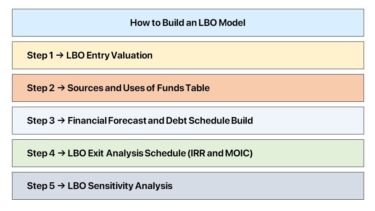Pro forma statements are projected financial documents that illustrate a company’s potential future financial performance, offering valuable insights into its financial health. As a forecasting tool, they enable financial professionals, business managers, and stakeholders to analyze “what if” scenarios, aiding in strategic financial planning and analysis (FP&A) and decision-making.
Explore the key applications and components of pro forma financial statements with this detailed guide:

- Pro forma statements forecast future financial performance based on assumptions and scenarios, aiding strategic planning and decision-making.
- They are key for financial modeling, valuation, M&A analysis, and capital raising by projecting future cash flows and demonstrating growth potential.
- Pro forma statements include projected income, balance sheet, and cash flow statements, relying on assumptions like sales growth and cost estimates.
- Accurate projections require well-documented assumptions, driver-based forecasting, and sensitivity analysis to assess different outcomes.
- They are essential for improving forecast accuracy, valuation precision, and capital-raising efforts, helping evaluate future business decisions.
What is Pro Forma in Finance?
Pro forma in finance is the creation and analysis of projected financial statements for future periods or hypothetical situations. These statements forecast a company’s financial performance based on various assumptions and scenarios. For instance, assumptions in pro forma financial statements may include sales growth projections or estimates of the cost of goods sold based on historical trends. In contrast, scenarios may include best-case outcomes with aggressive growth and high profitability or worst-case outcomes with economic downturns and market shifts.
By providing a forward-looking perspective, pro forma statements enable financial professionals to evaluate the potential impact of various business decisions, such as mergers, acquisitions, capital expenditures, and loan applications. They are crucial for strategic financial planning, helping to determine a company’s financial health and position under different hypothetical situations.
As projections, it’s crucial to understand that pro forma financial statements do not guarantee future results. Therefore, users of these statements must carefully scrutinize the underlying assumptions. While pro forma statements may not be bound by Generally Accepted Accounting Principles (GAAP) in the same way as historical financial statements, they can still follow internal standards or industry-specific guidelines, although they may lack the consistency of GAAP-based reports. However, for public companies, the SEC requires reconciliation of non-GAAP financial measures with the closest GAAP equivalent when used in external reporting, as per Regulation G..
Applications of Pro Forma Statements
While built on assumptions, pro forma statements are powerful tools in various financial analyses. For finance professionals, understanding these applications is key to effective decision-making:
Financial Modeling and Forecasting
Pro forma statements are the foundation for sophisticated financial models, allowing analysts to project future performance based on different scenarios and assumptions. They facilitate driver-based forecasting, where key business metrics (customer acquisition rates or pricing changes) directly influence projected financial outcomes.
For instance, a tech startup might use pro forma statements to model how different customer acquisition strategies affect revenue growth over a five-year period, helping executives allocate resources to the most promising growth channels.
Valuation and M&A Analysis
Pro forma statements are also necessary in calculating future cash flows for discounted cash flow (DCF) valuations and determining an organization’s intrinsic value. During mergers and acquisitions, these statements help quantify potential synergies and evaluate the combined entity’s financial outlook.
So, when Company A considers acquiring Company B, pro forma statements might reveal $10 million in annual cost savings through consolidated operations and demonstrate how the acquisition improves EBITDA margins from 15% to 18% within two years.
For instance, during Disney’s acquisition of 21st Century Fox in 2019, their pro forma statement played a vital role. It helped project combined revenues, estimate synergies such as cost savings from consolidated operations, and assess how the acquisition would impact key metrics like EBITDA. These projections were crucial in helping Disney secure investor confidence and ultimately finalize the deal.
Capital Raising and Financing
When seeking external funding, pro forma statements demonstrate a company’s financial viability and growth trajectory to potential investors or lenders. These projections help communicate the business case and expected returns, serving as critical components in pitch decks and loan applications.
If a solar technology startup presents five-year pro forma financials to venture capital firms, they might show how a $20M Series B investment would generate positive cash flow by year three and deliver a 40% IRR. The projections would demonstrate how capturing 2% of the commercial solar market in Sunbelt states would drive EBITDA margins from negative to 23% by year five as their proprietary technology reaches manufacturing scale.
During Airbnb’s Series A funding round, pro forma statements projected how the company would scale over time, helping to secure the necessary $7.2 million in funding. The projections outlined how Airbnb’s market share would grow, showing expected profitability from expanding its user base and refining its platform.
Key Components of Pro Forma Statements: A Detailed Breakdown
Pro forma statements are constructed using three core financial statements—an income statement, a balance sheet, and a cash flow statement. Unlike traditional financial statements, however, pro forma financial statements use assumptions to forecast potential financial outcomes.
Here’s the breakdown:
Pro Forma Income Statement
Pro forma income statements project future revenues, cost of goods sold, operating expenses, and ultimately, net income based on established assumptions. These assumptions include sales growth rates, gross margin improvements, or cost-cutting initiatives.
A manufacturing company might project COGS decreasing from 60% to 55% of revenue over three years based on anticipated economies of scale and automation investments, demonstrating improved profitability despite increased competition.
Pro Forma Balance Sheet
Pro forma balance sheets forecast the future state of company assets, liabilities, and equity while maintaining the fundamental accounting equation. These projections reflect anticipated changes in working capital, fixed assets, debt levels, and shareholder equity.
A retail chain expanding into new markets might project inventory increasing by $5M and accounts payable by $3M as sales volume grows 30%, while long-term debt increases temporarily before declining as new locations become profitable.
Pro Forma Cash Flow Statement
Pro forma cash flow statements project future cash movements across operating, investing, and financing activities, highlighting periods of surplus or deficit. These statements reveal the timing and magnitude of anticipated cash flows, which often differ significantly from accrual-based income projections.
A growing software company might forecast negative operating cash flow in year one due to increased hiring, followed by strong positive cash flow in years two and three as subscription revenue scales while capital expenditures remain relatively flat.
Creating Pro Forma Statements
Creating and analyzing pro forma statements requires a rigorous approach, emphasizing accuracy and thorough analysis to ensure reliable projections.
Key Assumptions and Driver-Based Forecasting
A successful pro forma analysis begins with well-documented, defensible assumptions based on historical performance, industry benchmarks, and realistic market conditions. Driver-based forecasting enhances accuracy by directly linking financial projections to key operational metrics:
Key assumptions and driver-based forecasting include:
- Core business drivers: Identify specific metrics that drive financial performance in your business model. Rather than generic growth percentages, focus on actionable variables like customer acquisition cost, conversion rates, and unit economics.
- Documentation: Document all assumptions with clear rationale, sources, and sensitivity thresholds. This creates accountability and enables others to validate your approach when reviewing the pro forma statements.
- Cross-functional input: Gather insights from operations, sales, marketing, and product teams before finalizing forecasting drivers. This collaborative approach reduces blind spots and ensures operational realities inform financial projections.
- Historical validation: Test your driver relationships against two to three years of historical data before applying them to forward projections, provided that historical data reflects similar operational and market conditions.. This validation step reveals where assumed relationships hold true and where adjustments may be needed.
Sensitivity and Scenario Analysis
A solid pro forma analysis requires testing how outcomes change when key variables fluctuate, providing a range of potential results rather than a single deterministic forecast.
This testing involves:
- Variable isolation: Test each critical assumption independently to understand its impact on financial outcomes. This isolation technique helps prioritize which variables require the most monitoring during implementation.
- Scenario development: Create three standard scenarios (base case, upside case, downside case) with clearly defined probability weightings. Avoid the common trap of presenting the most optimistic scenario as the base case.
- Correlation awareness: Identify variables that typically move together and incorporate these relationships into your analysis. Recognize that during market disruptions, historical correlations may break down or intensify.
- Stress testing: Examine extreme but plausible conditions to evaluate financial resilience and covenant compliance. This exercise reveals potential breaking points in your business model that require contingency planning.
Pro Forma Statements: Essential in Financial Analysis
Mastering pro forma statements is fundamental to effective financial analysis. With the right training, you can significantly improve your financial forecast accuracy, valuation precision, and capital-raising efforts. Wall Street Prep’s online resources provide the training for this skill set and can empower you to deepen your understanding of strategic analysis.
Wall Street Prep’s specialized training equips you to expertly construct and analyze pro forma statements, enhancing financial forecast accuracy, valuation precision, and capital raising efficacy. Our comprehensive courses deliver the practical knowledge needed to optimize financial modeling and deepen your strategic analysis skillset.
Enhance your financial modeling skills with expert pro forma statement analysis. Learn to construct, interpret, and leverage pro formas for accurate valuation, M&A, and capital raising. Explore our online courses and certificate programs to master financial forecasting and advance your career today.




